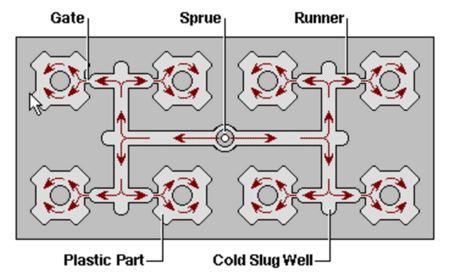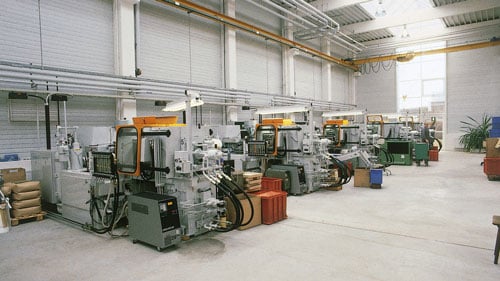Resources
Why Use Injection Molding
The principal advantage of injection molding is the ability to scale production en masse. Once the initial costs have been paid the price per unit during injection molded manufacturing is extremely low. The price also tends to drop drastically as more parts are produced. Other advantages include the following:
- Injection Molding produces low scrap rates relative to traditional manufacturing processes like CNC machining which cut away substantial percentages of an original plastic block or sheet. This however can be a negative relative to additive manufacturing processes like 3D printing that have even lower scrap rates. Note: waste plastic from injection molding manufacturing typically comes consistently from four areas: the sprue, the runners, the gate locations, and any overflow material that leaks out of the part cavity itself (a condition called “flash”).

Image From Ferris.edu
A sprue is simply the channel that guides molten plastic from the nozzle of the injection molding machine to the entry point for the entire injection mold tool. It is a separate part from the mold tool itself. A runner is a system of channels that meet up with the sprue, typically within or as part of the mold tool, that guides the molten plastic into the part cavities within the mold tool. There are two principal categories of runners (hot and cold) which you can read about here. Lastly, the gate is the part of the channel after the runner that leads directly into the part cavity. After an injection mold cycle (typically only seconds long) the entirety of the molten plastic will cool leaving solid plastic in the sprue, runners, gates, part cavities themselves, as well as a little bit of overflow potentially on the edges of the parts (if the seal isn’t 100% right).
Thermoset material, such as an epoxy resin that cures once exposed to air, is a material that cures and would burn after curing if one attempt is made to melt it. Thermoplastic material by contrast, is a plastic material that can be melted, cool and solidify, and then be melted again without burning. With thermoplastic materials the material can be recycled are used again. Sometimes this happens right on the factory floor. They grind up the sprues/runners and any reject parts. Then they add that material back into the raw material that goes into the injection molding press. This material is referred to as "re-grind". Typically, quality control departments will limit the amount of regrind that is allowed to be placed back into the press. (Some performance properties of the plastic can degrade as it is molded over and over). Or, if they have a lot of it, a factory can sell this re-grind to some other factory who can use it. Typically regrind material is used for low-quality parts that don't need high performance properties.
-
Injection Molding is very repeatable. That is, the second part you produce is going to be practically identical to the first one etc. This is a wonderful characteristic when trying to produce brand consistency and part reliability in high volume production.

What Is The Downside To Injection Molding:
Up front costs tend to be very high due to design, testing, and tooling requirements. If you are going to produce parts in high volumes you want to make sure you get the design right the first time. That is more complicated than you might think. Getting the design right includes:
-
Designing and then prototyping the part itself to specification
- Initial prototype development is typically completed on a 3D printer and often in a different material (such as ABS plastic) than the final part will be constructed in
-
Designing an injection mold tool for an initial production round
- Typically generating 300-1000 injection molded prototypes in the production material requires the development of an injection mold tool.
- Refining any and all details in the injection mold tool prior to mass-production in an injection mold manufacturing plant.
Potentially negative aspects of injection molding include the following:
- Two of the major disadvantages to injection molding are the high tooling costs and large required lead times. Tooling is almost a project in and of itself and only one phase of the entire injection molding process. Before you can produce an injection molded part you first have to design and prototype a part (probably via CNC or 3D printing), then you have to design and prototype a mold tool that can produce replicas of the part in volume. Lastly, and typically after extensive testing in both of the aforementioned stages, you get to injection mold a part. As you can imagine, all of the iteration required to get the tool correct prior to mass production requires both time and money. It is rare that you would prototype an injection molding tool. It does happen though, especially for parts that will be made in a multi-cavity tool. For example, let's say we were going to injection mold a new shampoo bottle cap. That cap would likely have threads to attach it to the bottle, a living hinge, a snap closure, and potentially some overmolding too. A company may choose to make a single cavity tool of that part to make sure all of the features will mold as desired. Upon approval, they will make a new tool, that is capable of molding, for example, 16 caps at a time. They do the single cavity tool first so if there are any issues, they don't have to pay and wait for it to be fixed 16 times for each cavity.
- Because tools are typically made out of steel (a very hard material) or aluminum it can be difficult to make changes. If you want to add plastic to the part you can always make the tool cavity larger by cutting away steel or aluminum. But if you are trying to take away plastic you need to decrease the size of the tool cavity by adding aluminum or metal to it. This is extremely difficult and in many cases might mean needing to scrap the tool (or part of the tool) entirely and start over. In other cases you might be able to weld metal into the cavity that is undesired.
- Injection molding necessitates uniform wall thickness. If you were to cut a cross-section of the Panasonic mold above you would notice that the wall thickness is approximately 2-3mm thick throughout. Keeping walls from being too thick is important to prevent inconsistencies in the cooling process resulting in defects like sink marks. A good rule of thumb is to keep walls less than or equal to 4mm thick. The thicker the walls the more material you will use, the longer the cycle time will be and the higher your cost per part will be. Conversely, if wall thickness is any thinner than 1mm or so you might experience trouble filling the mold tool (resulting in gaps or short shots). Designers can compensate for this potentiality by using a material with a higher melt flow index like Nylon which is often suitable for walls as thin as 0.5mm. Different manufacturing techniques like CNC don’t require uniform wall thickness at all.
- Oftentimes large parts cannot be produced via injection molding as a single piece. This is due to the size limitations of injection mold machines and the mold tools themselves. For example of a large injection molded part consider the shopping carts at Target. Although the machinery exists to mold very large pieces (e.g. 1000 ton presses roughly the size of a train’s caboose), using it is very expensive. For this reason, objects that are larger than a typical injection molding machine’s capability are most often created in multiple pieces. CNC machines have similar limitations regarding product size while 3D printing has even more limitations. CNC is limited to the travel and size of the bed in the milling machine while large 3D printed parts often need to be printed in multiple pieces and then bonded together.
- What affects injection mold machining accuracy and productivity?
- Shenzhen top five mold manufacturers: how plastic products are processed and produced?
- Shenzhen Ideal Vowin mold manufacturer: how to effectively improve the precision of mold processing?
- Chrome plating, a process that makes cars stylish
- Six injection molding processing technologies for home appliance plastic products
- Advantages and disadvantages of injection molding vs blow molding
- What is automotive hot stamping and molding technology?
- What is the difference between a hot runner and a cold runner in the mold?
- Automotive stamping die in large, precision and other areas of progress is obvious, the rapid development of plastic and rubber molds
- The top ten problems that are likely to occur in the mold testing process














